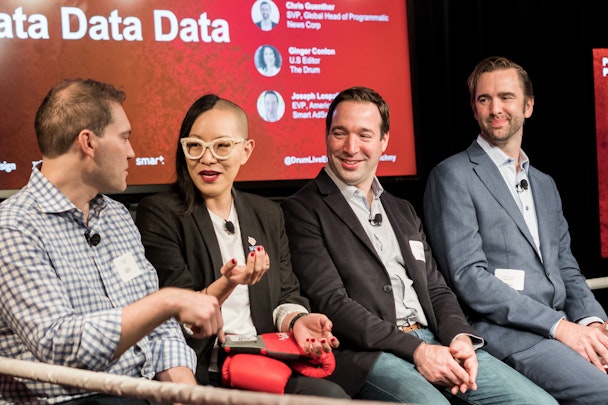Tackling data collection and attribution issues: Programmatic Punch NY
The issues of data collection and attribution continue to grow in complexity, especially post-GDPR and the passing of the California Consumer Privacy Act 2018.

Tackling the issues surrounding data collection and attribution: Programmatic Punch NY
At The Drum’s Programmatic Punch NY 2019, senior professionals from PMX, News Corp, Smart AdServer, and Visible discussed the problems they face around data and how they are attempting to solve them.
Effective use of customer data
One of the largest challenges is around compliancy what to leverage due to both GDPR and CCPA, according to Smart AdServer executive vice president of Americas, Joseph Lospalluto. Although a European based company, Smart AdServer operates globally.
He said: “We’re under strict compliance as a data processor. From that perspective, we're waiting on when a data controller signals a piece of data coming to us. There are very explicit rules in terms of what we can and cannot do with that. We really have to abide by what we're told.”
Eyes are certainly on California law, he added, but from that perspective, they are really just an enabler for the publishers that they work with. “Some of the ways that we do work with them is whether our platform is flexible enough to ingest data sets from their CMPs. We'll leverage that in terms of targeting capabilities that they want to do.
“Then we typically have a round trip so that we can feed data that happens on a particular ad tied to that data segment back to our publishers to then utilize machine learning or whatever else towards what their business is with that person.”
Minjae Ormes, chief marketing officer at Visible, believes that everything they are doing from a data perspective, particularly in programmatic, is all about learning about who they thought would be attracted by the offering that they have versus who's actually coming over. It is about re-establishing the direct to consumer relationship:
“As much as the media platforms and channels will become the scale builder, right now, at this stage for our business, it's really about learning about the audiences,” she added. “We literally have one $40 single plan, no stores, no hidden fees, no taxes. So, if we're thinking about that, there's probably some orientation around the value that people are looking for. But just because you care about the value doesn't mean every single person who cares about value looks and feels the same.”
As an agency, PMX is essentially collecting similar data as all of its peers. It has started using machine learning and AI to figure out how they can begin evolving what they’re buying in the traditional digital worlds across, apps, desktop web etc. and model how they can take those audiences into new places like OTT and addressable linear.
“We’re also trying to replace and disrupt those different types of areas where we believe that programmatic will be pervasive across all media types,” explained Yale Cohen, PMX’s executive vice president of digital investment and standards. “Our mission is to start making more data-informed decisions using the tools and platforms that we have, and also building out our own to make those decisions.”
The 'creepy' factor
For a new brand like Viable, the twin challenge within the wireless industry is how crowded it has become, and also the fact that everybody is spending a bunch of money to try to win people over.
Ormes explained: “We somehow have to break through that in a way that isn't annoying and creepy. We have to make sure that we do work well from an ROI standpoint, and make different decisions about how many times we show up in somebody's lives.”
Cohen said that it's also about the value of exchange with the consumers. If you're targeting them in the right place, they recognize that value much quicker.
Chris Guenther, senior vice president, global head of programmatic at NewsCorp added that they are constantly looking at making sure their privacy is updated, being as transparent with their users as possible and having that one-to-one relationship with them, as an example.
“We have to have a high standard of trust because if something appears creepy or they're uncomfortable, they're going to blame us,” he explained. “They're not necessarily going to blame some vendor we're working with or something on the backend, they're going to blame us.”
Creepiness is a symptom of an industry that has gone out of balance, added Lospalluto: “The pendulum has swung too far with programmatic that it's become easy: we ingest data, even if we don’t know what the data is, but let’s just ingest it ‘cause we need it.
“Privacy to Smart AdServer is about what did the consumer give you the right to do. And so as a platform then what are we informed to help do within whichever regulatory environment we're working in. We'll have to change our methodologies based on what we've been accustomed to having always been able to do.”
Attribution
Cohen insisted that digital attribution is definitely working, although there are still challenges within the walled gardens, getting it to cross-screen, and making sure the frequency of messaging to the consumer is correct. “We're trying to make programmatic more pervasive across all screens, platforms and media types,” he explained. “In that effort, attribution needs to not just be serving a message and then having a study that tells you three to six months later that you're actually brand health metrics went up or down. Attribution needs to be more real-time.”
Ormes added that they think about attribution both in and of itself for digital media, as well as how digital attribution could help Visible grab directional sense of the other types of marketing activities that they do:
“In our marketing activities, we often do things in real life, like a pop-up shop or influencer activities, that are not necessarily a clickable experience. That's why we work with our teams, agencies, and publishers to figure out if we're doing something right in real life to then make sure that we create an experience around it digitally.”
She concluded: “In the wireless industry, the consideration timeline is long because people are either tied into contracts or they still have to pay their phones off and they're thinking about it. There are around 300 different types of phone plans that you can choose from right now. Knowing that, and as a new brand, we have to make sure that we're thinking about the journey in which we introduce ourselves to people, and how… the digital attribution can also tell us something that we're not doing, the non-digital marketing activities.”
Programmatic Punch New York took place on June 6. If you missed out on this event, our UK variant will take place this December, find out more information here. Or, join us in New York for Programmatic Punch US 2020.


